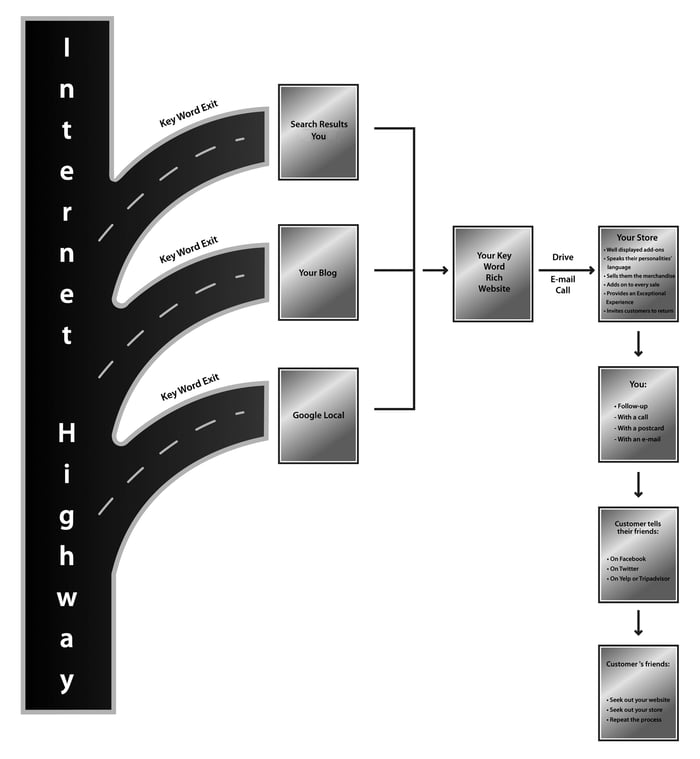7 Sales-Boosting Social Commerce Retail Marketing Strategies

Subscribe to our newsletter
I remember when a local business group asked me to present for half a day and the focus became social media marketing for retail stores.
It was a typical group of small and medium-sized businesses that sold everything from clothing and sporting goods to banking services, insurance, and technology.
Their members didn’t see much value in social media and didn’t use it often.
Those retailers struggled because they kept to their preconceived marketing ways and failed to see how social media and better website design would help them grow their sales.
How relevant is social commerce today?
Recommendations from friends and family remain the most credible form of advertising for 89% of today’s consumers, as reported in a recent Nielsen Global Trust in Advertising Report.
And where do those shoppers turn when they want to get their recommendations for themselves?
If you aren’t engaging your tribe of followers to comment, like, and share, none of their friends will be exposed to your brand.
Recommendations from friends and family are the number one way people find your store.
Branded websites are the second most trusted marketing format. People use search engines to discover the best stores in their area, and Google prioritizes those in its results.
Why do Google reviews and Facebook reviews matter to your business? People are typing Best ___ store in their search boxes, and Google looks at those reviews to determine who to show first.
With no reviews or few reviews and rotten reviews, you’re virtually invisible back on page three of search results.
What is the number three most trusted way shoppers choose one product or business over another? Two-thirds trust online consumer reviews, again pointing out your need to actively solicit them. One company I’ve found to help you with this is Podium.
But social media isn’t done in a vacuum.
Let’s back up a moment …
When I wrote my book, The Retail Doctor’s Guide To Growing Your Business (Wiley), I included this graphic at the back to explain how the web worked.

Back then, marketing on the web was all about keywords, as that was the primary way Google and other search engines worked. (If you don’t understand me so far, you can search the web for a ton of information about keywords.)
Nowadays, keywords are still important, but Google and other search engines have evolved to understand topics just as much as keywords.
Does that make keywords dead? No, because you need to understand exactly what people are searching for in your niche and the keywords they use to find you.
These 7 retail social media marketing strategies get results
Most companies fail when starting with retail social media because they see it as just another way to advertise. Social media is just that … social.
These seven core strategies for marketing your retail store on social media make it easy to attract your target customer, start a two-way rapport, and build trust.
1. Take note of the keywords that shoppers use when they talk to you
You will notice your keywords in things like a social media question, a submitted Contact Us form, or when they email you. Any time you see something like:
- I’m looking for a ___
- Can you help me with my ____
- How do I _____
...the words used to fill in the blanks probably match the words they used in their search queries. Write them down. The more you validate your keyword research with actual customer data, the more you can fine-tune your social media retail marketing.
Use those keywords on your homepage, online store, About Us page, and Contact Us page. They should also be on your social media profiles for Facebook and the rest.
2. Create topic clusters
Topic clusters are a relatively new idea. A topic cluster tells search engines that you have a real depth and understanding of your content and gives you more authority.
Say you have a housewares store in Idaho. You might have a web page on pans, recipes, and herbs and oils. You want to find a broad subject to hold all three pages.
Your topic or cluster might be How To Cook Fish or Best Way To Cook Trout, and you would write enough new content and link to your other three pages to form more of a topic page than a keyword page. Those internal links keep visitors on your site longer; they use your total website rather than one piece of it, and search engines love to see that deeper engagement with your content.
3. Pay for a website overhaul
90% of your shoppers start their search online. Even if they find you through your social media posts, they’ll visit your website to learn more.
You can’t afford to have your website built by your friend’s daughter’s boyfriend’s buddy, who builds them for free. A beautiful but poorly built site is invisible online.
Your website should be redone every three years to remain competitive, and the person responsible must understand the architecture that runs your site. You don’t just change it willy-nilly. You have to be strategic.
4. Be social on social
Take the best of what your store is and does, and find ways to engage your online community on Facebook and the rest through polls and videos.
So many retailers think posting a picture with 20% off is the ticket for social media. It isn’t.
That’s just a different way to give a coupon. Or they only show their crew having fun. I have news for you - that doesn’t work either. Viewers want to see things aimed at their needs and wants.
5. Be responsive in your social media accounts
The number one way to build respect and devotion from your online tribe is to be responsive. You’ll discover your own statistics of how quickly you respond to inquiries on your Facebook site in the right-hand margin of your fan page - and so can your followers.
Here is how to set up a Facebook auto-responder to let them know you received their message. The key, though, is to try to reply to every comment or message within minutes, not hours or worse ... weeks. You can see from my own page that even I have to respond more quickly.

6. Provide educational content
This is true for both your social media marketing and your website. Followers want you to show them how to address some of the common problems they face with your products. Facebook Live is a great way to do that. One intimate apparel store showed how to wash a bra properly. Another clothing retailer showed how to refresh a denim jacket. You get the idea. They follow you for insights, not just pictures.
7. Provide behind-the-scenes content
Unboxing videos are popular on YouTube, so why not show your Facebook and Instagram Fans what you just got in?
Putting up a trade booth somewhere? Show them how it’s done.
Doing a charity event? Tell them why and how they can get involved.
The goal is to make your fans feel part of something and get the inside scoop. It adds emotion and human connection, which doesn’t happen with a product picture.
How do you improve the performance of your social media retail marketing? Be authentic, responsive, and a trusted resource for information, and cluster your information to gain search engine mojo.
Turn social media marketing engagement into retail sales
What is the importance of social media in getting more sales? Simple, your posts put a face to your business that a website or a coupon cannot.
So many retailers think the web and social media are like foreign countries where only Millennials can understand the language. They are not. These sources are where we gather information before buying online or entering our cars for a special trip to your brick-and-mortar store.
Your social media goal is no different than it should be in your store. The number one priority is engagement.
I’ve only scratched the surface of how to market your business better to grow your store sales. But you know what?
Being social online is irrelevant if you aren’t social in-store.
You need to commit to the hard work of creating an exceptional experience for every person who walks in your door. That takes much more than letting your employees fake engagement or perform at a minimum level dusting your merchandise or standing sullen behind your counter.
You have to have a retail selling process that takes a visitor from A to B to C just as quickly and thoughtfully as you would online. I suggest you check out my SalesRX.com program.
You might have fun on social media as you take these tips and use them, but don’t forget marketing only gets them to your door; the best way to make more sales is by controlling the customer experience within your own four walls.



